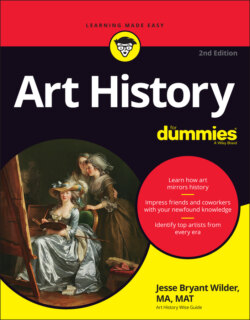Читать книгу Art History For Dummies - Jesse Bryant Wilder - Страница 12
Connecting Art Divisions and Culture
ОглавлениеArt history is divided into periods and movements, both of which represent the artwork of a group of artists over a specific time period. The difference between a period and a movement has to do with duration (periods are typically longer than movements) and intention (movements have specific intent). See Chapter 3 for more about art movements. An art period can last anywhere from 27,000 years to 50 years, depending on the rate of cultural change.
Here is a brief list, with examples of art periods and related cultural attributes:
Prehistoric art, the first leg of the longest art period, starts with the first known art around 30,000 BC, give or take a few thousand years, and lasts until the end of the Paleolithic period, or Old Stone Age, around 10,000 BC. The exact duration depended on where the artists lived with respect to the receding Ice Age. In those days, culture changed about as fast as a glacier melts — and this was long before global warming.
Prehistoric art, the next leg of the first period, the Neolithic or New Stone Age, lasted roughly another 6,500 years, from 10,000 to 3,500 BC, again depending upon where people lived. In the first period, people used stone tools, survived by hunting and gathering (in the Old Stone Age) or agriculture (in the New Stone Age), and didn’t know how to write — these are the period’s defining cultural characteristics.Painting hit rock bottom during the New Stone Age (the Neolithic Age), despite the fact that they had better stone tools, herds of domesticated animals, and permanent year-round settlements. But architecture really got off the ground with massive tombs like Stonehenge, temples, and the first towns. Although they couldn’t write, Old and New Stone Agers sure could express themselves with paint and sculpture. In the Old Stone Age, artists painted pictures of animals on cave walls and sculpted animal and human forms in stone. It seems their art was part of a magical or shamanistic ritual — an early form of visualization — to help them hunt.
The Neoclassical art period, by contrast, only lasted about 65 years, from 1765 to 1830. The pressures from the Industrial Revolution accelerated the rate of social and cultural change after the mid-18th century.
